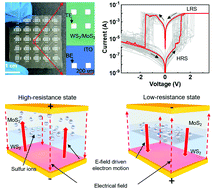An ultrathin memristor based on a two-dimensional WS2/MoS2 heterojunction†
Abstract
Memristors are regarded as one of the key devices to break through the traditional Von Neumann computer architecture due to their capability of simulating the function of neural synapses. Among various memristive materials, two-dimensional (2D) materials are promising candidates to build advanced memristors with extremely high integration density and low power consumption. However, memristors based on 2D materials usually suffer from poor endurance and retention due to their vulnerability to material degradation during the formation/fusing processes of conductive filament channels within the switching media of 2D materials. Here, a new memristor architecture based on a WS2/MoS2 2D semiconducting heterojunction (metal/heterojunction/metal, MHM) is proposed, which is completely different from the conventional metal/insulator/metal (MIM) sandwich structure. Through the introduction of a type-II 2D heterojunction, a resistance switching mechanism based on band modulation rather than the conductive filaments can be realized to eliminate the material degradation during the set/reset processes. A prototype MHM memristor based on the WS2/MoS2 heterojunction is successfully developed with a large switching on/off ratio up to 104 and a clearly extended endurance over 120 switching cycles, showing the advantage of the 2D WS2/MoS2 heterojunction over the individual MoS2 or WS2 layers in memristive performance. The proposed method for the MHM-type 2D memristor has the potential to achieve a large-scale integrated memristor matrix with low power consumption and high integration density, which is promising for future artificial intelligence and brain-like computing systems.



 Please wait while we load your content...
Please wait while we load your content...